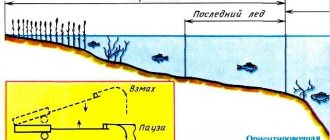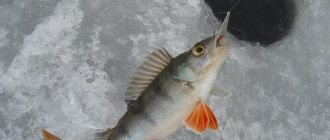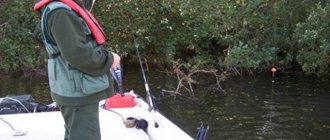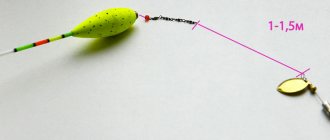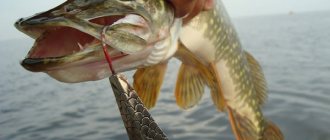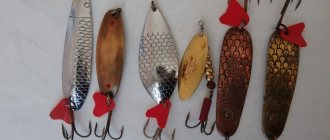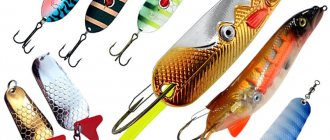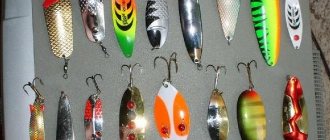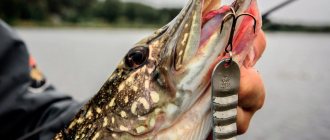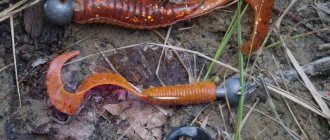Homemade pike winter lures - oscillating and gliding, with bodies of different sizes, shapes and colors are shown in the photograph.
Perhaps lures for pike fishing are less popular among winter fishing enthusiasts than perch and pike-perch spoons, but in reservoirs stocked with pike they can be very promising if you know how to manage vertical pike tackle.
Therefore, five pages of this topic are given to fishermen interested in making intensely oscillating and far-gliding homemade lures for pike to suit their needs and tastes.
Next, we will talk about my homemade spoons of different colors and shapes, tested in practice during winter fishing and creating the most intense disturbances in the aquatic environment, which the pike perceives with its lateral line, being quite far from the hole with the vertical bait lowered.
You can see the pattern drawing and appearance of one of the homemade winter pike gliding lures to the left of the text.
The color of the homemade pike made from polished stainless steel is bright light. Download the rest of the visual aids in the archive.
All material in the section is divided into pages, at the bottom of which there are links to other articles on the topic devoted to the description of pike lures, the technique of fishing with vertical tackle and the technology of self-manufacturing oscillating winter baits.
A separate material is devoted to metals suitable for the manufacture of pike winter vertical gliding spoons, recommendations are given on the choice of the shape and color of the petals of the bait.
Following the links you can go to pages with simple technical processes for making homemade winter pike lures from scratch to the setup stage.
Homemade pike gliding and oscillating spoons can be soldered at home without much difficulty from everyday materials. To catch pike, I use the same winter gear that we use to catch perch and pike perch vertically in winter and summer.
Oscillating winter homemade pike spoon
I divide my homemade winter pike lures for winter fishing into oscillating and gliding.
Although homemade spoons when fishing for pike in a vertical line, of course, are also gliding baits.
In pike lures that oscillate intensely during the fishing process, the bending of the longitudinal axis is double-sided. The picture shows a spoon for vertical pike fishing with a polished yellow front surface.
The nose and tail of each homemade winter lure for pike fishing are curved in opposite directions.
Intensely noisy wide pike spoons have a small length to width ratio. Usually these are relatively thin and wide in relation to the length winter vertical baits.
Homemade oscillating spoons are better than others for catching pike during pauses after top retrieves. And the noise or acoustic vibrations produced by any vertical bait depend on the shape of the vertical spoon.
Pike rigs in summer - instructions for making gear and catching the predator
In this article, we examined for you the process of making a pike girder with your own hands, talked about its correct equipment, installation and features of fishing with its use for predators in the summer.
The classic version of a pike fishing rod is a slingshot carved from wood or made from wire with equipment wound on it.
The main components of the girder equipment are:
Use such simple gear throughout the open water season to catch not only pike, but also large perch and pike perch.
You can fish with girders on such reservoirs as:
- flowing lakes and ponds rich in thickets of aquatic vegetation;
- small rivers and streams with fallen trees, flooded snags, thickets of water lilies and reeds;
- backwaters of large rivers and large reservoirs.
The main advantages of the zherlitsa include:
- ease of manufacture;
- fairly quick installation;
- the most common self-hooking of pike that has swallowed live bait;
- no need for constant monitoring.
Among the disadvantages, many anglers point out a certain passivity of girder fishing - in most cases, the pike takes live bait and hooks itself when the fisherman is not around.
Also, the disadvantages of this gear include the very frequent breakage of the line due to the fact that the hooked fish goes into nearby reed thickets or snags and there the line gets tangled in underwater stems or submerged tree branches.
As a result, the fisherman has no choice but to break the line, losing both the catch and a significant part of the equipment.
Planning homemade winter pike spoons
Far-gliding, but less noisy homemade pike spoons of red and white colors are shown in the photograph.
Upright gliding winter baits have a thickened shape with a one-sided bending of the longitudinal axes.
The top winter vertical pike spoon (made of red copper) in the picture acquired gliding properties due to its concave plane.
The front covering of the homemade pike vertically gliding spoon, shown in the photo below, is fine-rolled polished white nickel silver.
Gliding spoons are most effective when fishing for pike in winter on lower retrieves, where my homemade ones do not develop high speeds, but can glide in a long arc.
The game of homemade pike bait is discussed in the topic Vertical spinner for vertical pike fishing.
Spinner-spoon
Very often this spoon is used when fishing for perch and you can easily make it yourself. Below we will similarly explain how to make a lure for perch with your own hands:
- Take thin sheet metal, steel will do just fine, if not, then you can take an ordinary tin can from any drink. Cut a square sheet with metal scissors and straighten it, this will make it easier to draw the contours of the bait.
- Our bait will be in the shape of a diamond, use a permanent marker to mark the dimensions on the sheet.
- Using metal scissors, cut out the prepared layout.
- Calculate where the minor axis is located, along it you need to bend the metal gradually giving the shape of the bait.
- After giving the workpiece a shape, you need to solder a small triangle of copper, this can be done using a soldering iron.
- Then the hook is soldered to the copper plate.
- You will need to secure a ring at the top of the triangle; it is necessary for attaching the fishing line. To do this, drill a hole, it is advisable to wet the drilling site, otherwise you may damage the drill or part.
- Finally, we need to sand our vibrator and then it will be ready for use. Below you can see photos of do-it-yourself spinners.
Read here Making a mandula with your own hands: instructions and main stages of making the bait (video + 115 photos)
Shapes of homemade pike lures
The shapes of homemade vertical pike lures of different colors are shown in the photograph. I would divide such winter homemade products, first of all, by the shape of the bend along the longitudinal axis. Also, oscillating winter pike spoons have distinct convex (concave) surfaces.
The shape of a homemade pike winter spinner is characterized by such parameters as the ratio of the length to the width of the body, the radius of the transverse bend of the workpiece and the thickness of the filling of the concave cavity of the sheer oscillating homemade product with heavy solder or lead.
About half of my homemade winter pike lures with narrow body shapes have a longitudinal axis curved along some varying radius of bend of the pike lure, but only in one direction. The rest of the spinners have nose and tail ends curved along different radii in opposite directions.
The first homemade winter pike spoons are elongated in the shape of a boat and are most promising when fishing for pike on long bottom lines. Such vertical baits have a predictable, relatively uniform gliding trajectory.
With wide-shaped oscillating spoons, pike are better caught on a slow top retrieve or on a pause after it. In open water I use the same baits for summer trolling of pike
Review of popular models
Pros:
- Easy to use and does not require special luster skills.
- Common spoon baits of this type are predominantly golden in color, appropriate in clear water;
- Good game at shallow depths.
Castmaster
Pros:
- Popular due to its effectiveness.
- A heavy spoon that has proven itself at great depths and strong currents.
- Wide distribution and low cost make the bait accessible to any angler.
- Huge selection of sizes and colors.
- Very often supplied with a shiny holographic sticker.
Pros:
- Time-tested model.
- Catchy with slow retrieve.
- Easy to make.
Pros:
- A believable game.
- Easy to use.
- Easy to make at home.
Pros:
- Original form.
- 2 types of game: small loop/movement from side to side with slight amplitude.
- It is possible for the hook to get caught on the fishing line when throwing the spoon.
Color of homemade pike lures
The color of homemade winter pike lures is selected according to the color of the most common live bait in the reservoir. Suppose, as shown in the photograph, homemade vertically gliding pike lures of a wide shape should be selected according to color, imitating perch and roach.
But considering that pike is an omnivorous creature, the color of vertical and horizontal homemade winter pike lures is not so decisive.
Moreover, pike react more not to the range of colors in which the homemade vertical bait is painted, but to their general color or shade of the spinner.
Therefore, at great depths (especially in winter) in reservoirs with not very clear water, it is advisable to use homemade pike spoons with uniform body shades for pike fishing, better polishing the surface of the substrate, expressing its bright natural color. Fortunately, homemade baits allow such mechanical processing.
And for pike fishing in rivers and lakes with clear water, the front surface of a winter homemade pike can simply be cleaned of oxide with fine sandpaper. The color of homemade spinners with a side filled with solder always has a matte light gray tint.
The photo shows two homemade oscillating pike lures.
Winter lures for pike - 5 best models, DIY
Spoons are the most effective means for those who decide to catch pike in the first ice, and one of the few that work in the dead of winter.
In terms of catchability, they are in no way inferior to live bait, but are much more convenient for transportation and storage. In addition, these baits, unlike supplies for passive fishing, will not let you get bored on the ice and will allow you to fully demonstrate your fishing skills. If we add to the listed advantages the ease of production at home, it becomes clear why winter spinners have many fans.
Review of popular models
Baron
Pros:
- Easy to use and does not require special luster skills.
- Common spoon baits of this type are predominantly golden in color, appropriate in clear water;
- Good game at shallow depths.
Castmaster
Pros:
- Popular due to its effectiveness.
- A heavy spoon that has proven itself at great depths and strong currents.
- Wide distribution and low cost make the bait accessible to any angler.
- Huge selection of sizes and colors.
- Very often supplied with a shiny holographic sticker.
Atom-2
Pros:
- Time-tested model.
- Catchy with slow retrieve.
- Easy to make.
Cicada
Pros:
- A believable game.
- Easy to use.
- Easy to make at home.
Nautilus
Pros:
- Original form.
- 2 types of game: small loop/movement from side to side with slight amplitude.
- It is possible for the hook to get caught on the fishing line when throwing the spoon.
Choice for pike fishing
Properly selected bait is the key to success. In this matter, you should first of all focus on experience, and in its absence, make efforts to acquire it. It is useful to understand that pike preferences can vary depending on conditions and differ in different bodies of water.
Size
It should be understood that this characteristic of the spinner, especially in winter, is one of the most important. Weight and size parameters are chosen based on ideas about the size of the future trophy, as well as conditions in its habitat, such as current and depth.
Small spoons are used if:
- Hunting for small fish is carried out.
- The fisherman is not afraid that in the intervals between pike bites, perch will be caught.
- A larger spoon does not bring results.
- It is known that pike is sluggish, capricious and cautious.
For example, during the so-called deaf winter, oxygen starvation makes itself felt. It makes the fish more passive and, when going out to hunt, the predator pursues a very small prey, which takes much less effort to catch.
Therefore, in such cases, the use of bait that imitates fry suggests itself and brings, albeit modest, but still trophies.
It makes sense to use large spoons when:
- You are only interested in large pike.
- Fish is active and not picky in its desire to fill its stomach.
On the first and last ice and on days of thaw, the pike experiences a frantic gluttony. At this time, she does not hesitate to snatch larger prey for herself. Then it’s time to take out your lures with a size of 12 cm and rush in search of a specimen of impressive size.
Form
Pike prefers wide baits. Their play in water is characterized by gliding with a large amplitude and the creation of a large number of vibrations. Narrow spoons cannot boast of this. And although they create the appearance of a wounded fish when waddling from side to side, they are primarily suitable for fishing for perch and pike perch.
Material
Traditionally, spoons are made of metals and alloys. The most common ones are:
- zinc;
- brass;
- bronze;
- copper;
Silver and gold-plated baits occupy a special place. Their special attractiveness to fish is a controversial issue. But fishermen treat such spoons with special reverence - as if they were relics. They emphasize the status of the owner and cause considerable disappointment if broken or lost.
Sometimes baits are made from various types of metals. This has practical implications. The vibrations created as a result of the difference in electrochemical potentials will draw additional attention to your gear.
An integral part of almost every spinner is lead solder. It serves not only to impart the necessary load, but also creates a streamlined hydrodynamic shape.
Color
Perhaps this is the most controversial and ambiguous parameter. On the one hand, the attention of a predator should be attracted by spinners colored in the colors of the fish included in its diet. Therefore, some lure lovers buy or make baits that resemble roach and ruff.
At the same time, bright lures of “flashy” colors have a good reputation. Other anglers only recognize spinners with metallic colors.
But there are still some universal tips:
- In muddy water the bait should be bright.
- At great depths and in cloudy weather it is better to use spinners of light colors, in sunny and shallow water - vice versa.
- representing a bleeding wound can bring success
- lures of metallic colors with a notch in the form of scales - in some cases this will make them more seductive.
- Holographic stickers add extra shine to baits and increase their visibility in clear water.
With your own hands
manufacturing process
Most winter lures are made using the following technology:
- on a metal plate .
- Cut it out using metal scissors.
- The edges of the resulting workpiece are turned and polished.
- The back side of the plate is treated with solder acid and a layer of lead is applied using a soldering iron.
- Iron ears are soldered into the resulting lead layer to attach the spoon to the fishing line and the hook to the spoon.
- After this, the spoon is polished and given the correct streamlined shape.
- Sand the front side to give it an attractive shine.
- Winding rings are inserted into the ears.
- A tee with a bright cambric and/or red or orange edge placed on it is suspended from the lower ring
Blitz tips
- A catchable spinner on a pond is worth its weight in gold. Therefore, avoid the unpleasant surprise of a pike biting it off. Use a leash.
- A large supply of baits will allow you to experiment with size, color and shape and find the optimal solution in the specific conditions of a given reservoir.
- The stronger the current, the heavier the spoon should be.
- Most anglers consider the image of eyes on baits to be an unnecessary prop, but the predator uses them as a guide when aiming. In addition, such target points are applied to summer wobblers with some success. It is useful to do the same with winter bait.
- a tarnished lure using wool or felt. The use of abrasive pastes is acceptable.
- Monitor the condition of the hooks . Sharpen dull hooks. Replace rusty ones: the taste of oxidized metal is well captured by fish in the water and causes a decrease in the number of bites.
- Find out/determine the most effective retrieves for each spinner. Learn to do them.
Source: https://lakeking.ru/ryba/pike/zimnie-blesny.html
Painting homemade pike lures
If you don’t have a suitable color material for soldering homemade winter pike lures or you want to paint the lure in a different tone, giving it maximum resemblance to live bait, then you can use acrylic paints.
You can paint a homemade winter lure for pike only on the side filled with solder, and sand or polish the opposite surface of white, yellow or reddish color.
Acrylic paints dissolve in water, mix with each other, dry relatively quickly and adhere well to the surface being painted. A painted homemade winter pike lure acquires a more saturated bright color if the surface of the vertical bait is coated with colorless varnish after painting.
True, I myself never had to paint my homemade metal lures for winter vertical pike fishing, but I painted wooden wobblers after production quite often.
Those fishermen who catch pike with homemade foam fish can paint pike baits with acrylic paints to any desired color that is fairly water-resistant.
Tips from experienced fishermen for pike fishing
- During autumn pike fishing, it is better to start fishing in the afternoon rather than in the morning. The color of the spinner should be light, and the bait itself should be of considerable size.
- Before the onset of cold weather, pike hide in the depths. To lure out a predator you need to take large baits that imitate small fish.
- In summer, pike can be found near the shore in thickets of algae. But she is often noticed near the deep edges. She often stands in ambush, and when she sees prey, she moves sharply in its direction and grabs the fish with lightning speed.
- If the water in the reservoir is clean, then you should choose the color of the bait that imitates the fish that are most abundant. For example, if there are a lot of roaches in the fishing area, then you should take silver pinwheels.
- If the water is cloudy and dark, then you should take pinwheels of bright colors, ones that are not found in the reservoir.
- Pike often eat their own kind. Therefore, it is worth painting spinners with a shape and color reminiscent of these predators.
- When a lake or river is heavily overgrown with algae and reeds, the bait should resemble an amphibian, which pike hunt here.
- If hunting is carried out from the shore, then start casting short distances first, gradually increasing the length of the throw.
Pike is always a desirable catch for a fisherman. It is better to catch it with the help of spinners, which are very easy to make at home without spending large sums on buying a famous brand. To make them more attractive, homemade pinwheels are painted in bright colors and decorated with woolen threads or a silicone skirt.
